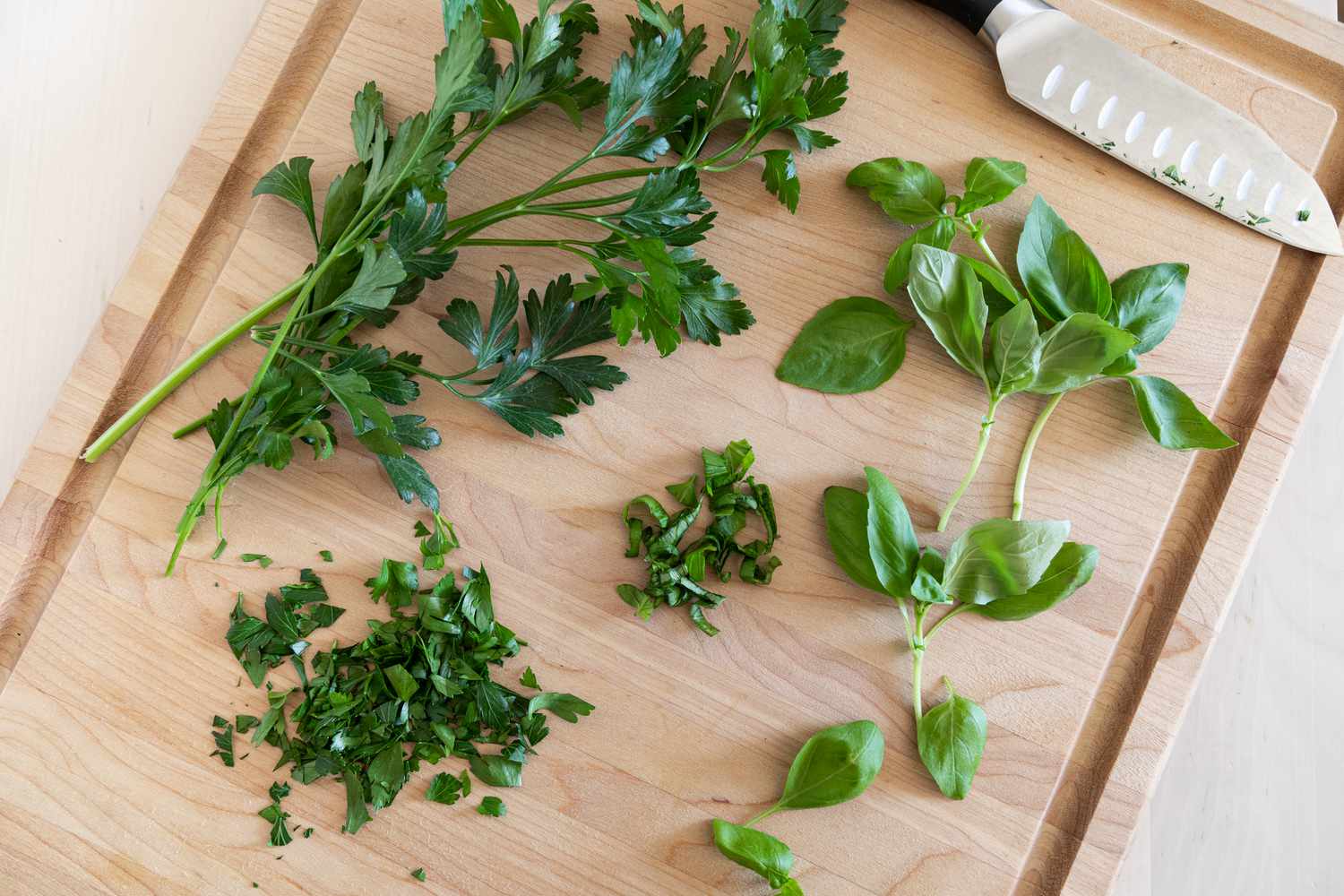In the bustling kitchen, the rhythmic sound of a knife meeting cutting board fills the air.
Coarsely chopping, a technique both artful and liberating, unlocks a world of flavors and textures in culinary creations.
With no set rules, this method allows for creative exploration, inviting chefs to play with shapes and sizes.
Delving into the realm of this knife-wielding adventure, we explore the magic of coarsely chopping, aiming to demystify the process and unveil its many culinary wonders.
So grab your favorite knife, and let’s embark on a flavorful journey together.
But be warned, the lure of the food processor may tempt us along the way!
coarsely chopped
Coarsely chopping refers to a technique commonly used in cooking where ingredients are cut into 1/2 to 3/4-inch chunks.
This technique is often applied to ingredients like nuts, chilies, onions, and vegetables.
While there is no standard method for coarsely chopping, some people follow the 1/2-inch or 3/4-inch rule while others chop based on their own understanding.
To successfully coarsely chop, it is important to have a good knife that you are comfortable with.
The recommended grip technique is the 3-finger grip, where the middle, ring, and pinky fingers hold the handle and the index and thumb hold the upper side of the blade.
It is also crucial to adjust the chopping method based on the recipe and visual clues in the dish.
Alternatively, a food processor can be used for coarsely chopping, although caution should be exercised to avoid over-processing and turning the ingredients into a paste.
Coarsely chopping can also be applied to certain meats, such as chicken, bacon, and beef, as an alternative to mincing.
Overall, the important thing is to enjoy cooking and to experiment with different techniques to achieve the desired result.
Key Points:
- Coarsely chopping involves cutting ingredients into 1/2 to 3/4-inch chunks.
- This technique is commonly used for nuts, chilies, onions, and vegetables.
- The size of the chunks can vary, with some following the 1/2-inch or 3/4-inch rule and others using their own judgment.
- A good knife and the 3-finger grip technique are recommended for successful coarsely chopping.
- The chopping method should be adjusted based on the recipe and visual clues.
- Caution should be taken when using a food processor to avoid over-processing the ingredients.
coarsely chopped – Watch Video
💡
Pro Tips:
1. Coarsely chopped vegetables actually retain more nutrients compared to finely chopped ones. This is because the larger surface area prevents excessive exposure to heat and oxygen during cooking.
2. Coarsely chopped garlic releases more allicin, a compound responsible for its health benefits, than minced or finely chopped garlic. So, next time you’re cooking with garlic, consider using larger chunks!
3. In traditional Japanese cuisine, coarsely chopped daikon radish is often used as a natural meat tenderizer. The enzymes present in this root vegetable help break down proteins, resulting in a juicier and more tender meat.
4. Coarsely chopped nuts are not only a tasty addition to various dishes; they also provide a higher quantity of healthy fats compared to finely chopped nuts. So, don’t be afraid to sprinkle some chunky nuts on your next salad or dessert!
5. When coarsely chopping chocolate for baking, different-sized pieces can result in varied textures. Larger chocolate chunks will melt slower, creating pockets of gooey chocolate, while smaller bits will blend more evenly, adding a subtle chocolate flavor throughout the baked goods.
Coarsely Chopping: Introduction And Definition
Coarsely chopping is a fundamental technique in cooking that involves cutting ingredients into 1/2 to 3/4-inch chunks. This technique is widely used in various culinary preparations, allowing for a combination of textures and flavors. Whether you are preparing a hearty stew, a refreshing salsa, or a crunchy salad, coarsely chopping ingredients can add depth and complexity to your dishes.
Commonly Coarsely Chopped Ingredients
Numerous ingredients benefit from being coarsely chopped to enhance their taste and texture. Nuts, chilies, onions, and vegetables are among the most frequently encountered ingredients that require this technique. Coarsely chopping nuts, such as almonds or walnuts, not only adds a satisfying crunch but also improves their ability to infuse their flavors into the dish. Similarly, chopping vegetables like carrots, bell peppers, or zucchini into coarse chunks can provide a delightful crispness and robustness to stir-fries and roasted dishes.
No Standard Method For Coarsely Chopping
When it comes to coarsely chopping, there is no one-size-fits-all method. In fact, different chefs and home cooks may adhere to their own understanding of what constitutes coarsely chopped.
While some favor the precise 1/2-inch or 3/4-inch rule, others rely on their own judgment based on the desired outcome and recipe requirements. The important aspect is achieving the desired size and consistency while maintaining the integrity of the ingredients.
Choosing The Right Knife For Coarsely Chopping
A good knife is crucial for successful coarsely chopping. Your knife should feel comfortable in your hand, enabling you to exert control during the chopping process. Rather than imitating others’ choices, it is best to choose a knife that suits your hand size and grip style. Invest in a high-quality chef’s knife or Santoku knife with a sharp and sturdy blade. A well-maintained knife will make the process easier, safer, and more enjoyable.
Techniques For Using A Knife To Chop Food
Mastering various knife techniques can significantly improve your efficiency and precision in the kitchen. When it comes to coarsely chopping, it is important to develop a good grasp of the basic knife skills. The claw method, for instance, is widely used for chopping onions into cubes. By curling your fingers into a claw shape, you can securely grip the onion while guiding the knife through the layers. This technique not only ensures your safety but also allows for more controlled and uniform cuts.
Recommended Grip Technique For Coarsely Chopping
To achieve optimal control and accuracy while coarsely chopping, it is highly recommended to use the three-finger grip technique. Place your middle, ring, and pinky fingers firmly around the knife handle, while your index finger and thumb rest on the upper side of the blade. This grip provides stability, balance, and dexterity, allowing you to maintain a steady rhythm and avoid any accidental slips.
Encouraging Experimentation And Enjoyment In Cooking
As with any culinary endeavor, coarsely chopping is an opportunity to explore and experiment with different techniques and flavors. Don’t be afraid to adapt your chopping style based on the ingredients, recipe, and personal preferences. Allow your creativity to flow in the kitchen and enjoy the process of transforming raw ingredients into delectable dishes. Cooking should be a joyful experience, and your passion and enthusiasm will undoubtedly enhance the flavors of your culinary creations.
Instructions For Chopping Onions Into Cubes Using The Claw Method
To finely chop onions into cubes using the claw method, follow these steps:
- Cut off both ends of the onion and peel away the outer skin.
- Make a lengthwise cut down the onion, but leave the root end intact.
- Lay the onion flat and make parallel horizontal cuts, making sure to stop just before reaching the root end.
- Lastly, make vertical cuts perpendicular to your previous ones, starting from the root end.
By using the claw shape to protect your fingertips, you can confidently and efficiently transform the onion into evenly sized cubes.
Adjusting Chopping Method Based On Recipe And Visual Cues
While guidelines and techniques are helpful, adapting your chopping method to suit the specific recipe and visual cues in the dish is important. For example, certain recipes may call for larger chunks for a rustic presentation, while others may require smaller pieces for more even cooking.
Additionally, it is crucial to consider the desired texture and cooking time when chopping ingredients. By adjusting your chopping technique based on such factors, you can ensure the best outcome and a harmonious integration of flavors and textures in the final dish.
Alternative Methods And Considerations For Coarsely Chopping Ingredients
For those who prefer not to hone their chopping skills or require larger quantities, a food processor can be a handy alternative. However, exercise caution not to over-process the ingredients, as they may end up turning into an undesired paste-like consistency. Keep in mind that specific ingredients, such as chicken, bacon, and beef, can be coarsely chopped instead of being minced or finely chopped, resulting in a more substantial and substantial texture in the final dish.
- A food processor can be a convenient alternative to manual chopping.
- Be careful not to over-process ingredients, as they may turn into a paste-like consistency.
- Coarsely chopping certain ingredients like chicken, bacon, and beef can add a more substantial texture to the dish.
💡
You may need to know these questions about coarsely chopped
What size is coarsely chopped?
Coarsely chopped refers to larger chunks of approximately 3/4 inch in size. This size creates more substantial pieces compared to a fine chop, which is about 1/4 inch in size. If a recipe does not provide specifics, chopped ingredients generally range from 1/2 to 3/4 inch pieces, allowing some flexibility in achieving the desired texture for the dish.
What size is coarsely chopped onion?
Coarsely chopped onion generally refers to pieces that are between ½ to ¾-inch in size. This size is larger than minced or fine pieces, but smaller than medium-sized chunks. When storing coarsely chopped onions, it is recommended to place them in a glass container or a resealable plastic bag, and then store them in an airtight container to maintain their freshness.
1. When should coarsely chopped ingredients be used in cooking and baking?
Coarsely chopped ingredients are typically used in cooking when you want a more rustic and chunky texture in the dish. For example, in dishes like stews, soups, or stir-fries, coarsely chopped vegetables or meat can add a nice texture and visual appeal. The larger pieces take longer to cook and retain their individual identity, providing a more robust bite.
In baking, coarsely chopped ingredients can be used when you want bursts of flavor and texture in the final product. For instance, in cookies or muffins, adding coarsely chopped nuts, fruits, or chocolate chunks can create delightful pockets of crunch or gooeyness. It adds variation to the texture and presents a more visually appealing appearance when bites of the chopped ingredients can be seen throughout the baked goods.
2. What are some popular recipes that call for coarsely chopped vegetables or fruits?
Some popular recipes that call for coarsely chopped vegetables include stir-fries, salads, and soups. In stir-fries, you might find coarsely chopped vegetables like bell peppers, carrots, and onions, which retain a satisfying crunch when cooked quickly over high heat. Salads often incorporate coarsely chopped vegetables like cucumbers, tomatoes, and radishes for added texture and freshness. And in soups, coarsely chopped vegetables like potatoes, carrots, and celery are common, providing a hearty presence in each spoonful.
In terms of fruits, several popular recipes call for coarsely chopped fruits. Fruit salads often feature a variety of coarsely chopped fruits like apples, oranges, and strawberries for a colorful and refreshing mix. Fruit salsas make use of coarsely chopped fruits like pineapples, mangos, or peaches to add a sweet and tangy element to dishes. Additionally, coarsely chopped fruits like berries or peaches are commonly used when making cobblers, crisps, or fruit pies for a chunkier and textured filling.
Reference source
https://misen.com/blogs/news/chopped-vs-diced
https://m.youtube.com/watch?v=ijMwmjbPjz0
https://m.youtube.com/watch?v=8IGii5N-AgE
https://boydhampers.com/blogs/guides/what-does-coarsley-chopped-mean



